
10 minute read
Facilities & Destinations: BALTIMORE
LAYING ON THE CHARM: BALTIMORE’S NEW TOURISM IMPROVEMENT DISTRICT AND BREAKTHROUGH MESSAGING TARGET LEISURE & BUSINESS TRAVELERS
BALTIMORE
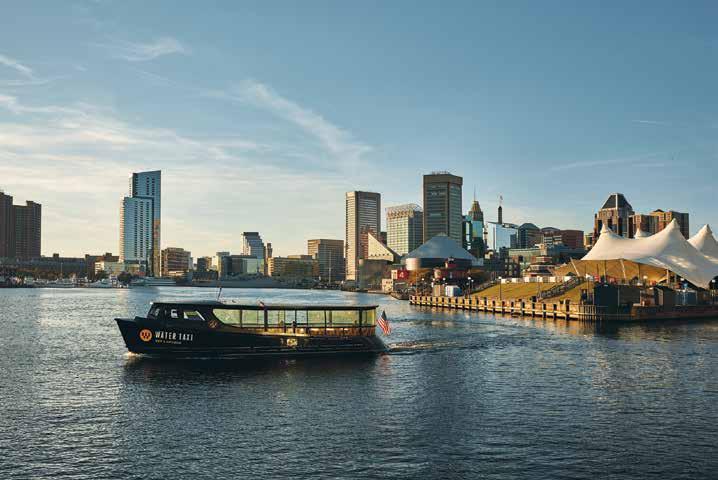
BALTIMORE'S INNER HARBOR
Charm City is poised to take its meetings business to the next level
When Al Hutchinson became President and CEO of Visit Baltimore in November 2016, one of his main goals was to help the city realize its full potential as a meeting destination. All the assets were in place: a formidable convention center supported by Hilton, Hyatt and Sheraton hotels, vibrant neighborhoods, world-class museums, a waterfront teeming with diversions and a rich sports culture centered around M&T Bank Stadium and Camden Yards. Yet Hutchinson, a 25-year hospitality industry veteran, also saw room for improvement on the destination marketing side. “As a DMO, we were underfunded, so in early 2017 we started having a conversation with our hotel industry and political leadership about the possibility of creating a TID [Tourism Improvement District], a model that has been very successful for a number of cities,” he explains.
That conversation bore fruit in May of this year, when Mayor Bernard C. “Jack” Young signed the Baltimore Tourism Improvement District ordinance into law. The BTID will ultimately increase marketing funds by about $7 million. “That’s a really big move for the city of Baltimore and our tourism industry,” Hutchinson says. “This new revenue stream will go directly to Visit Baltimore, and it will be primarily used for new sales and marketing initiatives that we can’t do today. From a sales standpoint, we’re going to be looking at increasing our footprint in the international market and maybe create some partnerships with BWI Airport to drive new carriers into the market.” One of the results of the boost in sales and marketing funding will surely be a continued upswing in convention business. Baltimore welcomes 28 citywide conventions this year, and the CVB projects 36 in the next fiscal year. The city is particularly well positioned to serve three vertical markets in the meetings industry: healthcare, education and, more recently, high tech. As to the first, “we’re top of the list for medical providers around the country, when you think of Johns Hopkins Medicine as well as University of Maryland Medical Center. So we have a lot of thought leadership in the healthcare industry,” Hutchinson says. “The other vertical that’s been very significant here is the education association market. We have about seven highered institutions here, and we partner with those institutions to drive that market to Baltimore. We also feel that the technology vertical is one of our new growth opportunities. Our community has a lot of Millennials that are very tech savvy and own startup companies. So we want to partner with those new technology leaders and attract more technology conferences to Baltimore.” These institutions and companies present planners with many possibilities for sourcing keynote speakers within healthcare, higher education and technology, and the CVB can certainly facilitate those connections.

“We’re excited about [the Baltimore Convention Center expansion; we think we have a huge opportunity to make this happen.” — Al Hutchinson, President and CEO, Visit Baltimore
BALTIMORE CONVENTION CENTER EXPANSION
and feel like they’re a part of the design work,” he adds. One aspect of the convention center that groups appreciate is its connectivity to three upscale hotels: The 757-room Hilton Baltimore Inner Harbor, 488-room Hyatt Regency Baltimore Inner Harbor and 338-room Sheraton Inner Harbor Hotel. The first two properties have recently completed renovations. The Hilton’s $13 million renovation included its meeting space, public areas and guestrooms, while the Hyatt invested $20 million into a guestroom makeover. In addition, the 750-room Baltimore Marriott Waterfront and 586-room Renaissance Baltimore Harborplace Hotel have completed multimillion-dollar guestroom renovations. The Hilton and Marriott properties have the most meeting space among Baltimore’s hotels, offering 110,000 sq. ft. and 50,527 sq. ft., respectively.
Baltimore will not only have more promotional resources thanks to the BTID, but it will also have more to promote with the eventual expansion of the Baltimore Convention Center. Currently, the facility houses 300,000 sq. ft. of contiguous exhibit space, about 85,000 sq. ft. of meeting space across 50 meeting rooms, and a 36,672-sq.-ft. ballroom. The Maryland Stadium Authority is leading the initiative to expand the exhibit space to 500,000 sq. ft. and add a connected, 500-room hotel. A second feasibility study is being conducted this summer. “We’re working very closely with the Stadium Authority as well as with the state and city leadership to determine the exact timeline,” Hutchinson says. “We’re excited about it; we think we have a huge opportunity to make this happen.” The project will be informed by input from the city’s convention clientele, in order to ensure their needs are met by the expansion as well as the renovation of the existing building. “We want to have more conversations with our customers because at the end of the day we think it’s important for them to see themselves in this new building
Baltimore also has 1,100 guestrooms coming online over the next 12 months, including the 156-room Canopy Baltimore | Harbor Point. Occupying the top four floors of the 12-story Wills Street Wharf office building, the Canopy by Hilton property will features an outdoor terrace with panoramic views of the Inner Harbor.
CAPTURING THE SPIRIT OF BALTIMORE
The best way to appreciate the virtues of Baltimore is of course to visit. But for those groups that haven’t met in the city, the CVB and its new creative and PR partners are crafting vivid messaging designed to tell the destination’s unique story. Rolling out in early 2020, the new campaign will include a redesigned Visit Baltimore website. “This is an exciting initiative that’s being led by our Chief Marketing Officer,” Hutchinson says. “We want to do it in a way that revives civic pride for our residents but also sends a national message to our leisure and business travelers about the beauty of Baltimore.”
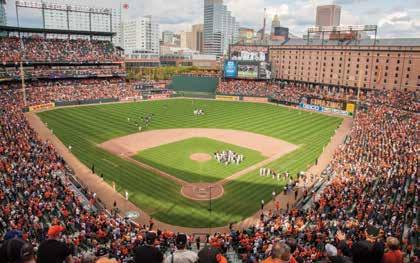
Whether catching a game at Camden Yards (above) or exploring the National Aquarium (below), attendees are sure to make memories during their free time.
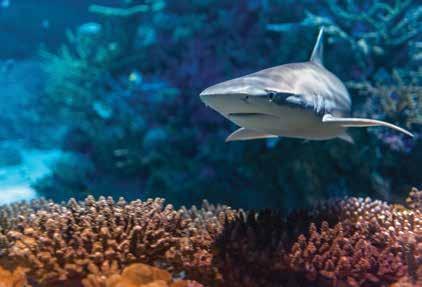
Hutchinson highlights numerous features of the city that will be woven into the rebranding: neighborhoods that entice the modern traveler looking for authentic local experiences; a startup business culture driven by Millennials; a thriving craft beer and rye whiskey industry; and an African American community that is integral to Baltimore’s history and growth. The Reginald F. Lewis Museum tells the story of African American Marylanders using documents, artworks and photographs dating from 1784 up to the present day. The museum is one of the finest institutions of its kind in the country and offers several rentable spaces for group gatherings. The Baltimore Museum of Art also offers rentable spaces, including the neoclassical Majestic Fox Court, Antioch Court and 363-capacity Meyerhoff Auditorium. The Walters Art Museum, which houses a culturally diverse collection, is another option for groups looking to gather in stately surroundings.
Offsite experiences go well beyond museums, of course. Planners can arrange a private tour of the world-class National Aquarium, or sightseeing outings to historic neighborhoods such as Federal Hill, Bolton Hill and Fells Point. The iconic Oriole Park at Camden Yards, with its retro design featuring a brick façade, is a great offsite option that has been utilized by many groups. “Planners love that venue,” Hutchinson affirms, “not just as sports fans but also because of its architecture.” Basketball fans can look forward to CIAA (Central Intercollegiate Athletic Association) tournaments in the city. In January, the organization selected Baltimore as the official site of the 2021-2023 CIAA Men’s and Women’s Basketball Tournament, which has been held in Charlotte for the past 13 years. Bowie State University will be the host institution. While delegates may not make it to a sporting event, they’ll almost certainly have time to sample Baltimore’s robust dining scene, which includes a variety of restaurants suited to group dinners. Examples include The Alexander Brown Restaurant, Phillips Seafood and Blackwall Hitch in the Inner Harbor; Blue Agave Restaurant and Hersh’s in Federal Hill; Bygone at the top of the Four Seasons Hotel and Apropoe’s at the Marriott Waterfront; and Ciao Bella and La Scala in Little Italy.
CVB SERVICE
The Visit Baltimore staff is an invaluable resource in navigating all these offsite possibilities, and they do more than simply provide a planner information and referrals. Hutchinson, who has had a long and successful career in destination marketing, knows what it means to go the extra mile for clients. “We want to come at it more from a consultant perspective,” he says. “We gather what the needs are from the group, what they are looking to do, and we make it more than a heads-in-beds conversation. And if they want to provide [attendees] some giveback opportunities, there are a number of organizations here in Baltimore that we can connect our convention planners to. That’s something that’s been very successful for us.”
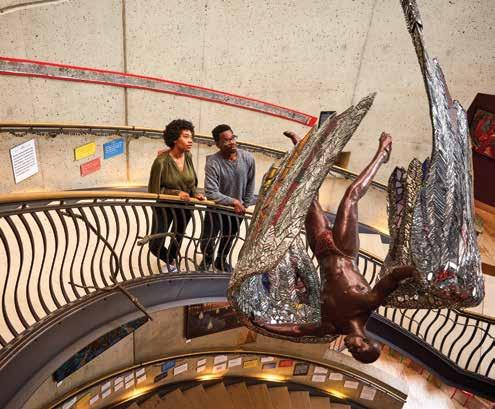
AMERICAN VISIONARY ART MUSEUM
Hutchinson and his staff convey a strong conviction in the city they promote. Baltimore can “charm” any group, especially once they step outside the convention center to explore its neighborhoods. “We want groups to get the true feeling of this community and the passion of the people here, so we want to take them out to our great neighborhoods,” Hutchinson says. “We’re one of these communities that once you see it, you fall in love with it.”
UNIQUELY BALTIMORE
The following seven sites exemplify “only in Baltimore” historic experiences that planners can offer their attendees, either via an offsite event or as a recommendation for their free time.
STAR-SPANGLED BANNER FLAG HOUSE Built in 1793, the Flag House became the home and business place of Mary Pickersgill in 1806. Pickersgill sewed the flag that was installed at Fort McHenry in 1813. Francis Scott Key saw the flag from aboard a British vessel during the Battle of Baltimore and was inspired to write the words that became our National Anthem. The Star-Spangled Banner Flag House Association established a museum at the home in 1927.
FORT MCHENRY - Designated a National Monument and Historic Shrine, Fort McHenry defended the Baltimore harbor during the War of 1812. The Fort is open to the public year round and offers visitor programs.
USS CONSTELLATION - Decommissioned in 1955 after 100 years of service, the USS Constellation is the only surviving ship from the Civil War era. A National Historic Landmark, the vessel is docked in the Inner Harbor. Of particular note is the ship’s role in ending foreign slave trade. By 1807, the importation of slaves was outlawed, although slavery remained legal. The USS Constellation enforced the law by capturing slave ships off the coast of Africa — a total of three ships carrying 705 Africans, including 199 women and children.
BALTIMORE & OHIO RAILROAD MUSEUM - Recognized as the birthplace of American railroading, the museum’s 40-acre campus was the site where construction of the B&O Railroad began in 1829. A National Historic Landmark and Affiliate of the Smithsonian Museum, the B&O Railroad Museum displays artifacts related to early American railroading, particularly in the mid-Atlantic region. The collection includes nearly 200 pieces of locomotives and rolling stock, countless small artifacts from the industry and plenty of scale models. Planners can rent the Museum’s signature building, the 1884 Baldwin Roundhouse, for up to 2,800 attendees. Other options include the 12,000-sq.-ft. pavilion and the 1948 “Royal Blue” Observation Lounge Car, which accommodates up to 35 guests.
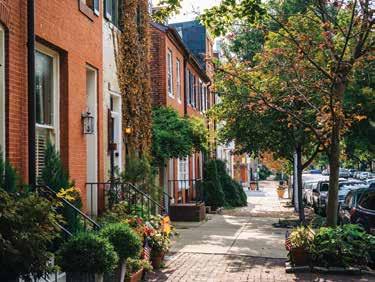
Federal Hill (above) is among the city’s many charming historic neighborhoods. The Reginald F. Lewis Museum (below) is devoted to the history of African American Marylanders.
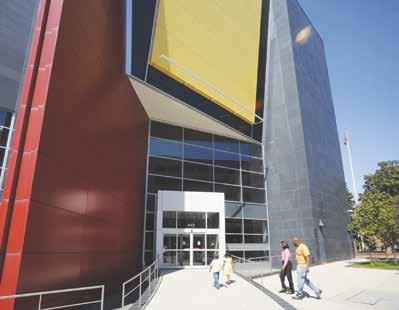
THE BASILICA OF THE NATIONAL SHRINE OF THE ASSUMPTION OF THE BLESSED VIRGIN MARY - Built from 1806-1821 and restored in 2006, the Baltimore Basilica is the first great metropolitan cathedral constructed in the United States after the adoption of the Constitution. Sitting on a hill overlooking the Inner Harbor, the neoclassical structure was designed to reflect the architecture of the new federal city in Washington. Reportedly, John Carroll, the country’s first bishop, had wanted a style that was considered “American” in contrast to the popular Gothic Revival architecture.
BABE RUTH BIRTHPLACE MUSEUM - George Herman “Babe” Ruth was born Feb. 6, 1895, at 216 Emory Street. The Baltimore row house, now a museum dedicated to Ruth’s legacy, lies three blocks west of Oriole Park at Camden Yards. Fully restored in 2015, the museum is available for rental, accommodating 125 guests in its exhibit rooms and courtyard.
PIMLICO RACE COURSE - Opened on Oct. 25, 1870, Pimlico Race Course is the second oldest racetrack in the nation behind Saratoga in upstate New York. Home to Preakness Stakes, the historic course has hosted generations of Baltimoreans who have cheered legendary horses such as Man o’ War, Sir Barton, Seabiscuit, Secretariat and Cigar.

